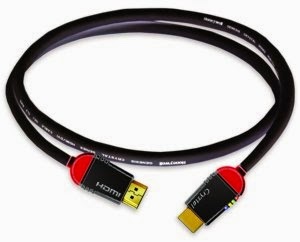 |
Getting the best audio connection
|
DVD/Blu-ray Player, Cable/Satellite set-top boxes
Digital Optical Audio Cable or 'Toslink' versus Digital Coaxial Cable - some people may have differing opinions on this one, but we prefer Toslink overall. Although a high-end Digital Coaxial Cable can deliver crisp, detailed sound, we find it to be a bit harsh at times (think action movies) and can lead to audience fatigue. Sound delivered by way of Toslink, however, has a bit more airy quality to it and seems to create a more enveloping sound stage (it should, the signal is literally carried by light waves over a fiber-optic cable). Good quality Toslink cables are still very easy to find and very affordably priced on the various internet cable sites.
These cables (Toslink and Digital Coaxial) are both capable of carrying Dolby Digital(5.1), DTS, 2.0 Stereo Surround, and PCM signals, the common audio formats that you normally find on DVD players and set-top boxes.
You can even use them with Blu-ray players, you just won't be getting the best possible sound. Hmmm....curious? Let's do some more decoding...
Good
Better
Best
Pictured above: Digital Coaxial, Toslink (Digital Optical Audio Cable) and HDMI Cable (from top to bottom)
'Cause Now You've Got a New Receiver that can receive the HDMI cable from your devices
If you've bought a Surround Receiver in the last few years, chances are it can receive HDMI inputs from your various devices and then output the same video and audio to the TV of your choice. In this scenario, the Receiver is actually acting as a 'switcher', changing the audio and video on the TV to match which device input you have selected to 'receive' on the Receiver itself.
If you have a Blu-ray player (or DVD player with HDMI up-conversion), or a set-top box with HDMI output, we recommend that you use the HDMI connections going from that device to the Amp/Receiver and then from the Amp/Receiver to the TV (all the way around).
Why? Well for one, it cuts down on the total number of cables used, since HDMI cables carry both the audio and video on one single cable.
Secondly, even the newest HDMI cables are fully backward compatible with the older formats and will still carry Dolby Digital 5.1, DTS, 2.0 surround, and PCM audio signals.
Thirdly, and most importantly, when you play a Blu-ray disc, you will now be able to take advantage of the new loss-less audio formats, namely Dolby TrueHD and DTS Master Audio. Toslink or Digital Coaxial cables cannot carry these new audio signals since they do not have the required bandwidth.
These formats are totally loss-less audio bit-streams, unlike 6 channel Dolby Digital 5.1, and offer 8 discrete channels of audio (the surround format is actually '7.1', the (.1) always indicates the sub-woofer channel). With Surround 7.1 you'll get 4 surround speakers (and discrete channels) instead of 2, a very nice upgrade if you like the potential for awesome Home Theatre sound. Any HDMI cable made in say, 2007 or later (after HDMI 1.3 released) should provide (you can visit our HDMI Releases page for more info on this topic).
So if you already have Toslink or Coaxial connected and you don't want to get up from the chair to start pulling apart connections, relax, you can still watch the newer stuff (like Blu-ray and HD DVD) with regular old Dolby Digital 5.1, etc., since just about every Hi-Def disc or player we have seen on the market is backward compatible in this way. But if you want to take advantage of these new loss-less audio formats, start picking up some more HDMI cables and get ready for some awesome sound (of course, don't forget to set your player to 'bit-stream' mode to ensure you are getting the best possible sound). (By the way, you can always go here for great low prices on HDMI and all other A/V cables).
Looking for the best video connection? Then visit our Best Video Connection page.
Looking for the best video connection? Then visit our Best Video Connection page.




You have done great work by publishing this article here. It is useful and convenient info for us.optical audio to speaker wire Keep upgrading our knowledge by share these types of articles.
ReplyDelete